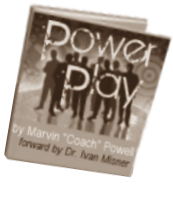The next few weeks are going to require a review of what you’ve already done so take a minute to go back and review weeks one and two before you post your work from this weeks assignment. You should have generated so many ideas by now that it’s hard to contain them.
If you haven’t already started with week one, go back to the “rules of the game” blog post and start there. It’s not too late, you might not get caught up with the contest but you can keep up with the class. We’ll bring the contest back again in the second quarter 2009 and you’ll have an early start.
**IMPORTANT** If you’re going to play along, don’t just do the exercises for yourself. Posting your results ads to the community of learning and helps others get to see and know your business. You’ll be surprised who’ll want to help you.
The next few lessons come almost entirely from Ivan Misner’s work on building a WOMBAT plan. I’ve put our unique spin on this but I highly recommend that you purchase his book “Business By Referral”. Please see sample exercise so that you’ll know how to post your results
Diversify your network activities
Start to identify your playing fields and your team mates
The selection process is very important. Don’t let chance decide where you’re going to spend your time and efforts. Remember, the key is to diversify your activities. One type of business organization will not serve all your needs. Therefore, you should consciously select a well-rounded mix of groups. Try to avoid being in more than one group that separates their membership by having one per category like a BNI chapter. If you have associates, partners, or employees, take their participation into account when deciding what groups you need to become active in you may not need to go!
List the names of the groups that you now belong to. Remember networks are active groups of people that meet regularly and know you by name. Ideally they have existing communications mechanisms like meetings, conferences and newsletters that allow members to interact. Groups today might even have a social networking component on-line for its members. Some groups are all virtual and never really meet physically.
Here are a few suggested places to analyze group information:
Guidestar– is a great place to check out associations. You’ll get information like; where they meet, how many members they have, what kinds of publications they distribute,
Facebook or LinkedIn ““ some groups have developed their own social networking site to allow members access to one another and facilitate information sharing. You can even post information (news) or ask questions within the groups. You may be able to book events or set up committee meetings on-line.
Gale-Cengage ““ This is the BIG Daddy of all association research tools and can be easily accessed on-line with your current library card.
List 5 groups that you are not a member of but would like to consider and why.
\
Which group do you think is most important and list the answers to the following questions:
How long has this group been in existence?
How many members does it have?
What is the quality of the membership?
Is it affiliated with a national or international group?
How focused is the group on its objectives?
How structured are the meetings?
How much does it cost?
How often are the meetings?
What do other members say about the group?
What is your overall impression of the group?
How much will you membership cost?
How much time will you set aside to attend meeting and network with members?
What networking goals will you accomplish through this group?
You’ll need to do this kind of analysis for each group so that you can work everything into your budget of money and time. Don’t be afraid to pick up the phone and speak to a membership director or chairman.
Feel free to e-mail Coach Powell with any questions!
Sample Posting
I currently belong to the five following groups:
The Retired Military Officers Association
The Fairfax County Small Business Commission
The National Association of Minority Government Contractors
Business Networking International
Rotary Club International
I’d like to be a member of:
The Mid Atlantic Venture Association ““ the venture capital groups that belong to this organization generally fund my clients. It would be great if they all know, like and trust me.
The Fairfax County Chamber of Commerce ““ is a great place to meet more golden geese that play at the BIG table
The Fairfax County Economic Development Authority ““ has their fingers on the pulse of all business activity in the region. They focus on bringing new businesses here.
The Virginia Society of Certified Public Accountants ““ they’ll know all of the best personal services companies in the area and be able to refer me. I can also sponsor their events and training.
Etc.
The National Venture Capital Association is my biggest networking target.
Since 1973 NVCA’s mission is to foster greater understanding of the importance of venture capital to the U.S. economy, and support entrepreneurial activity and innovation.
NVCA has approximately 335. Member Venture capital organizations, corporate financiers, and individual venture capitalists who are responsible for investing private capital in young companies on a professional basis.
The NVCA and it’s members represents the public policy interests of the venture capital community, strives to maintain high professional standards, provides reliable industry data, sponsors professional development, and facilitates interaction among its members. How focused is the group on its objectives?
All meetings are two day conference style meetings with training and executive breakout sessions
It’ll cost roughly $30,000 to play which includes both annual meetings and sponsorship activity
NVCA has two annual meeting – 2009 Apr. 29 – 30, Boston, Massachusetts, United States; 2010 May 4 – 5, Burlingame, California
Etc.

Speak Your Mind